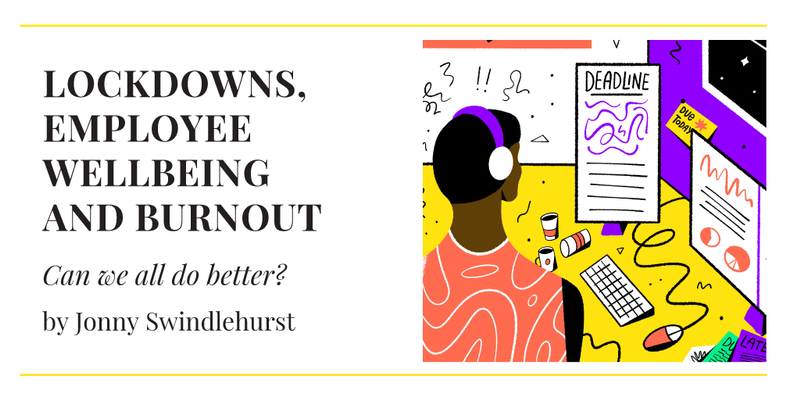
I had to stop. I couldn’t look at my screen any longer. The simplest of tasks felt insurmountable. I was irritable, exhausted and to be honest a little upset. Tears were close and the tightness in my chest was acute.
This was a couple of weeks ago. It was a sign that my body and mind were both giving it – at least for a while. I hadn’t been listening to the warning signs. But it’s so difficult during lockdown. If you’re working, it’s natural to feel guilty with so many others out of work. Feelings of guilt too easily creep in when it comes time to take a break.
I’d neglected exercise, ignored the stress, stretched out my working day to well beyond what is reasonable, and just carried on. Until I couldn’t carry on much longer. And this is just me. Just a small snapshot of how I was feeling on a Tuesday morning when everything became too much. It’s not necessarily an extreme case and is likely becoming the norm for plenty of people up and down the country. It can be summed up in one word. Burnout.
BURNOUT AND THE TECH INDUSTRY FOR TOO LONG HAVE GONE HAND IN HAND
Around 60% of tech workers have suffered burnout. But this was before coronavirus, you can only imagine what the numbers are now. And as we enter lockdown 2.0 is it really our primary focus or are we ignoring it to get the job done in increasingly stressful times?
For those at the very top of the industry, burnout can almost be a badge of honour. Is a start-up story a real start-up story without it at some stage? When it comes to the employees on the ground, however – those tasked with leading the charge – these are the stories we don’t always hear.
In our latest Digital Evolution podcast, we caught up with Amber Coster, Founder and CEO of Balpro. Balpro help businesses to balance aggressive revenue goals with employee wellbeing, something that is essential in today’s tech industry. Amber knows this first-hand. In her own words, burnout left her “feeling like my entire body and brain just totally shut down. To the point where I couldn’t speak properly, and I couldn’t walk down the road for more than 10 minutes”.
Amber’s story is an inspiring one – the podcast makes for urgent listening. It led to her running the London Marathon after her problems walking and founding her business. For the purpose of this article, we’ll focus on some of her warning signs.
She reached her start-up aspirations, rung the bell at Nasdaq and was on a billboard in Times Square. Pretty impressive, right? She describes it as a “funeral”. It was the ultimate “Instagram moment” where the reality just didn’t add up to the perception of the dream. She was tired and broken and all that hard work felt like it didn’t matter anymore.
While many of us might not get to these heights, it’s likely plenty of us can relate to this feeling.
WARNING SIGNS ARE EXACTLY THAT: A WARNING TO STOP
These are two very different examples. One extreme. One which could easily be seen as typical. But both share some commonalities. And it’s about the warning signs.
In our industry we’re spending more time in front of the screen than ever before. We’re experiencing 2020’s phenomenon of Zoom fatigue. Mass remote working has seen our brains having to work harder and feel like they’re always on. But at the same time, we’re continually distracted by instant messaging. It’s not a good combination.
Burnout is described by the Mayo Clinic as a state of physical, emotional or mental exhaustion combined with doubts about your competence and the value of your work. Key signs include lack of motivation, difficulty completing normal tasks, brain fog, inability to concentrate, and having a low mood.
Dominic McGregor, formerly the Founder & COO of Social Chain and a mental health advocate, recently provided his 10 signs to look out for.
• Your concentration has decreased
• You’re not sleeping well
• You have a decreased motivation to do things that align with your goals
• You feel depleted of energy
• You feel you’re doing your best, but it isn’t enough
• You feel “on edge”
• You’ve started turning to unhealthy outlets for comfort (drinking)
• You’re acting out of character
• You break down over little things
• You start questioning things you normally feel secure in
SELF-AWARENESS IS A GREAT PLACE TO START. AS IS BEING AWARE OF OUR CURRENT CIRCUMSTANCES.
With a winter lockdown, daily exercise is harder, nights spent outdoors may be impossible, and as your work WhatsApp keeps pinging it can feel like the lines between home and work are becoming even more blurred.
Stopping and taking a break might feel hard, but it is essential.
THE EMPLOYEE EXPERIENCE HAS A FUNDAMENTAL ROLE TO PLAY
The recognition of burnout — its signs and causes — has to infiltrate all areas of an organisation. As a senior leader for example you may recognise the signs in yourself and have seen some in your staff.
But you have the ability to make real positive change. It all comes down to the employee experience – this is more important now than ever. It might not always be easy for employers to implement in the current climate, but it has to be a priority.
The following is key:
• Equipping managers with the ability to understand employee workloads: tech is of course essential to track time, but regular check-ins are fundamental to identify any potential well-being issues and undue pressure.
• Putting employee wellbeing front and centre in your culture: listen to what your employees want over and above the traditional benefits. What information can you provide? Can you offer access to online coaches and support networks? How can this be tailored to the individual needs of your workforce?
• Educating all staff on burnout signs: this helps with self-recognition, but also with managers knowing what to look out for.
• Providing the tools needed to manage stress: it is key for managers to mentor staff in terms of prioritising, delegating and focusing on tasks (this includes switching off Slack and WhatsApp at key times), but also encouraging employees to take appropriate breaks and not pushing them to be continually available outside work hours.
• Encouraging balance: be aware that once deadlines have been met and big projects have been delivered, provide an opportunity for your staff to decompress before the pressure ramps up again.
• Personalising the employee experience: just 1 in 10 employees are asked what would improve their employee experience. Around 1 in 2 are never asked at all. Just by asking the question and listening, you can make positive changes.
• Pushing back on clients when you have to: this is easier said than done, but if client pressure becomes too much, push back is essential. Clients are human too, and the understanding of needs should be a two-way street.
As unpredictability abounds and the world around us changes, we’re all facing pressure from a variety of angles. But remember, we’re all in this together and we will come out the other side.

For more insights and articles, check out the second issue of The Colectiv – a digital publication from J B Cole.